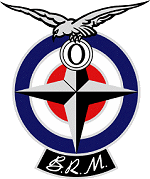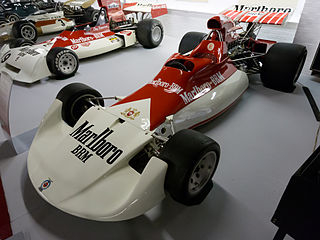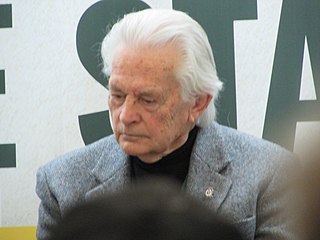
British Racing Motors (BRM) was a British Formula One motor racing team. Founded in 1945 and based in the market town of Bourne in Lincolnshire, it participated from 1951 to 1977, competing in 197 grands prix and winning seventeen. BRM won the constructors' title in 1962 when its driver Graham Hill became world champion. In 1963, 1964, 1965 and 1971, BRM came second in the constructors' competition.

Pedro Rodríguez de la Vega was a Mexican racing driver. He began his Formula One career in 1963, won the 1967 South African Grand Prix in a Cooper and the 1970 Belgian Grand Prix in a BRM. He was the older brother of Ricardo Rodríguez.

Jean-Pierre Maurice Georges Beltoise was a French Grand Prix motorcycle road racer and Formula One driver who raced for the Matra and BRM teams. He competed in 88 Grands Prix achieving a single victory, at the 1972 Monaco Grand Prix, and a total of eight podium finishes.

Keith Jack Oliver is a British former Formula One driver and team-owner from England. He became known as the founder of the Arrows team as well as a racing driver, although during his driving career he won both the 24 Hours of Le Mans race and the Can-Am championship. Oliver was also the second person to complete the informal triple Crown of endurance racing.
Charles Anthony Standish Brooks was a British racing driver also known as the "Racing Dentist". He participated in 39 Formula One World Championship Grands Prix, competing for the first time on 14 July 1956, and achieved six wins, 10 podium finishes and 75 career points. He was third in the World Drivers' Championship in 1958 with Vanwall and second in 1959 with Ferrari. He also scored the first win by a British driver in a British car in a Grand Prix since 1923, driving a Connaught at Syracuse in 1955 in a non-championship race.
British Racing Partnership (BRP) was a racing team, and latterly constructor, from the United Kingdom. It was established by Alfred Moss and Ken Gregory – Stirling Moss's father and former manager, respectively – in 1957 to run cars for Stirling, when not under contract with other firms, along with other up-and-coming drivers.
Gilby Engineering was a British general engineering company owned by Syd Greene. Greene had lost an arm in a bicycle accident at 16 but went on to compete in many UK speed trials very successfully in the early 1950s. After he stopped competing, he fed his enthusiasm for motor racing by founding a motor racing team named after his company and later constructing the Gilby racing car. The team competed in 12 Formula One World Championship Grands Prix, including 6 with cars of their own construction, but scored no World Championship points. The Gilby cars were constructed by Syd Greene for his son Keith to drive, having previously entered a Maserati 250F for Roy Salvadori and Ivor Bueb and also a Cooper for Greene Jr. Keith Greene later became better known as a team manager in Formula One and sports car racing. Gilby made its debut in the 1954 French Grand Prix with the Maserati, for Salvadori, who also drove for the team in 1955 and 1956, and the team's last event was the 1962 Italian Grand Prix. After the team ceased competing in Formula One, the final Gilby car was purchased and entered in three events in 1963, by privateer Ian Raby. Keith Greene achieved a third-place finish in the non-championship Naples Grand Prix of 1962, with the BRM-engined car, behind the works Ferrari's of Willy Mairesse and Lorenzo Bandini.

The Lotus 49 was a Formula One racing car designed by Colin Chapman and Maurice Philippe for the 1967 F1 season. It was designed around the Cosworth DFV engine that would power most of the Formula One grid through the 1970s. It was one of the first F1 cars to use a stressed member engine combined with a monocoque to reduce weight, with other teams adopting the concept after its success. It also pioneered the use of aerofoils to generate downforce.

The Lotus 43 was a Formula One racing car designed by Colin Chapman for the 1966 season. Hampered by its heavy and unreliable BRM engine, it won only one race, the 1966 United States Grand Prix.

The BRM P261, also known as the BRM P61 Mark II, is a Formula One motor racing car, designed and built by the British Racing Motors team in Bourne, Lincolnshire, England. The BRM P261 was introduced for the 1964 Formula One season, and its design was an evolution of Tony Rudd's one-off BRM P61 car of 1963. The P261 had a relatively long racing career; variants of the car were still being entered for Formula One World Championship Grands Prix as late as 1968. During the course of their front-line career, BRM P261s won six World Championship races, in the hands of works drivers Graham Hill and Jackie Stewart, and finished second in both the Drivers' and Constructors' Championship standings in 1964 and 1965. Stewart, Hill and Richard Attwood also used works P261s to compete in the Tasman Series in 1966. The BRMs dominated, with Stewart winning four, Hill two, and Attwood one of the 1966 Tasman Series' eight races. Stewart also won the title. The works-backed Reg Parnell Racing team returned in 1967 with Stewart and Attwood, where Stewart added another two wins to his tally. In terms of races won and total championship points scored, the P261 was the most successful car in BRM's history.

The BRM P207 was a Formula One racing car, designed by Len Terry and constructed by British Racing Motors, which raced in the 1977 Formula One season. It was powered by a 3.0-litre V12 engine, with a claimed output of 488bhp. London-based Swiss watchmakers Rotary Watches provided sponsorship money. The car failed to score any points during the season. The team made a total of nine entries during the season, but only qualified in one instance, at the 1977 Brazilian Grand Prix. Driven by Larry Perkins, the car retired on lap one due to overheating. Its qualifying time was six seconds slower than that of the second-to-last starter. One British journalist in Brazil exclaimed that he was ashamed of being British. The car failed to appear at the season opening Argentine Grand Prix because it was too wide to fit in the hold of the aircraft that was going to transport it to South America.

The BRM P180 was a Formula One racing car, built by BRM and designed by Tony Southgate which raced in the 1972 Formula One season. It was powered by a BRM 3.0-litre V12 engine. One of the main features of the P180 was that the radiators had moved to the rear of the car, allowing the nose of the car to be very wide and flat. It competed in five World Championship Grands Prix, with a total of seven individual entries. The car scored no World Championship points, its best finish being eighth at the 1972 Italian Grand Prix.

The BRM P153 was a Formula One racing car designed by Tony Southgate for the British Racing Motors team, which raced in the 1970, 1971 and 1972 Formula One seasons. It was powered by a 3.0-litre V12 engine. Its best result was victory at the 1970 Belgian Grand Prix, where Pedro Rodríguez beat the second-placed March of Chris Amon by just 1.1 seconds. The model was first shown in BRM's traditional British racing green, but by the time it appeared on the race tracks it was in the colours of the team's sponsor, Yardley of London.

The BRM P138 was a Formula One racing car designed by Len Terry which raced in the 1968 and 1969 Formula One seasons. It was powered by a 3.0-litre V12 engine.

The BRM P133 was a Formula One racing car which raced in the 1968 and 1969 Formula One seasons.

Tony Southgate is a British engineer and former racing car designer. He designed many successful cars, including Jaguar's Le Mans-winning XJR-9, and cars for almost every type of circuit racing. He was responsible for the chassis design of Ford's RS200 Group B rally car. Southgate was employed as chief designer or technical director for many Formula One teams for over twenty years. These teams included BRM, Shadow and Arrows. Southgate retired after producing the Audi R8C, which was a major influence in the Bentley Speed 8, which won Le Mans in 2003. He continues to be a regular visitor to current and historic race meetings.

The Shadow DN1 was a Formula One car used by the Shadow team during the 1973 Formula One season and the early stages of the following season. The car was the first Formula One car for Shadow, which had previously participated in the CanAm Sportscar Series. It was designed by former BRM engineer Tony Southgate. The DN1 was also driven by Graham Hill for his privateer team, Embassy Hill.

The BRM P25 was a Formula One racing car raced from 1956 to 1960 and the second car produced by the British Racing Motors consortium. After the failure of the complex BRM V16, the P25's design emphasized simplicity. The car was fitted with a 2.5-litre straight-4 engine, producing some 275 horsepower. The P25 would be the foundation of BRM's successes in the late 1950s and early 1960s.

The BRM P48 was a Formula One racing car raced in 1960. It was BRM's first rear-engined car. With rear-engined cars in the ascendancy, BRM hastily reworked the front-engined, now five-year-old P25. The car proved to be slow and unreliable, and was replaced by the P48/57 the following year.

The BRM P57 was a Formula One racing car built to race in Formula One from 1962 to 1965.

















